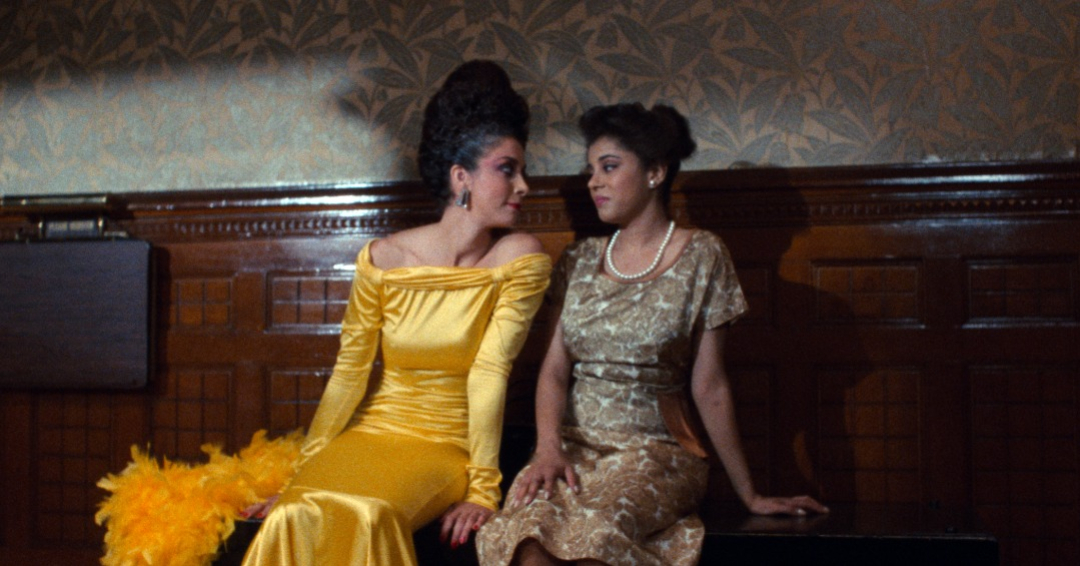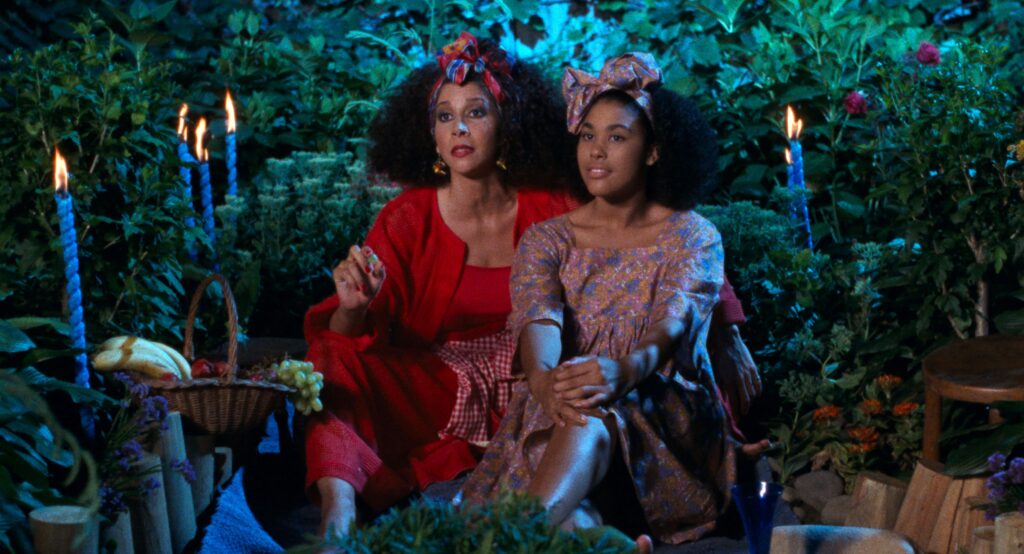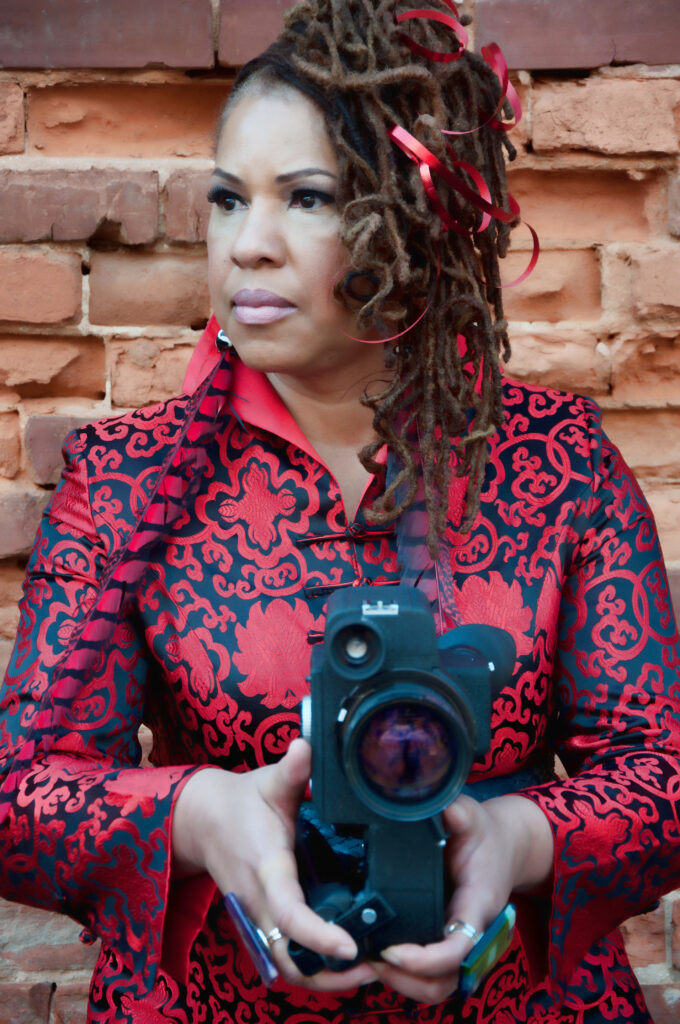
15 Sep Ayoka’s Rainbow: Her Colorful Tale of Womanhood 30 Years Later
BY GABE CASTRO
A matriarchal tale of womanhood, art, and love, Alma’s Rainbow showcases Black joy and sisterhood through laughter and drama. The story is told through the eyes of three remarkable women: the straight-laced and independent mother; the artistic, french-speaking, free-spirited aunt; and lastly, the talented and sweet young Rainbow, who is learning to accept her growing body and all the potential it holds. Filmmaker Ayoka Chenzira creates an inspiring atmosphere of community, love, and acceptance. Born and raised in Philadelphia, Chenzira grew up surrounded by a community of oral storytellers in her mother’s beauty parlor in North Philadelphia.
Nearly 30 years after its original premiere, Alma’s Rainbow is as remarkably charming as ever, exploring the complex and beautiful relationship between mothers and daughters, a woman’s growing body, and finding our place in the world.
cinéSPEAK spoke with Chenzira about the film and how 30 years later, it is as impactful and inspiring as its premiere.
Gabe Castro: Can you talk a bit about your process and the inspiration for Alma’s Rainbow? Why this story and [told] this way?
Ayoka Chenzira: Well, I grew up in Philadelphia. My mother had a beautiful beauty parlor in North Philadelphia. It was the first place I learned about storytelling. And specifically, storytelling from a woman and girl’s perspective. My mom also loved the movies, so I was taken to movies a lot and sometimes age-inappropriate ones. Some of the inspiration is autobiographical from me growing up but also later when I myself became a mom.
Looking at other young people and moms, I realized that girls and mothers were having a hard time with each other. There are these long-standing tensions that we often see in movies. But, for me, I realized that one of the things that we don’t see often is that our caretakers are still on a journey as well. Even though in some cases it appears as though they’ve given up their lives to raising the children, they’ve taken on the role of mother. Which has a particular meaning frequently, that you give up big parts of your life to raise a child. And so I wanted to look at some of that. I wanted to look at a girl who had some options, including the glamorous art life, and what her journey is like. How she thinks about the world versus the much more conservative view of the world her mother has. And to see how those two things can be embraced, but also collide.

GC: I really resonated with the matriarchal aspect of the story. This community of women uplifting and supporting each other. One of the scenes that struck me the most was when Rainbow gets her period. The community of women around her begins instructing her and passing on their knowledge. Can you talk about this approach to the story, to have a feminine and matriarchal lens where the men are supportive tools for the main characters to figure themselves out? What does it mean to you to have such a strong focus on the female journey, and their community with other women?
AC: As I mentioned previously, at a very early age, my daily life was spent in my mother’s beauty parlor surrounded by women and women telling stories. As a young person, I had a sense of the bigger world, through the eyes of women who were part of this community. Some were family members while others were like extended family. There are a lot of women that I called aunts who weren’t blood-related, but certainly, in terms of interaction, they were very much like family. So this community of women is something that I naturally carry with me, in my spirit and in my psyche.
GC: I was really thankful that the film focused on and featured at the forefront, Black joy, passion, and the very real experiences and connectivity of the community. We’re so used to seeing Black trauma prioritized on screen, so this felt special. Can you share your thoughts on the importance of creating a space that’s celebrating Black joy, and our journeys?
AC: Black trauma has become a genre, which is painful. It’s painful to me. It’s not that those stories aren’t important, but it seems that when it comes to Black life and culture, it gets defined for us by others. You can tell a lot about what people are thinking by what is selected and what is not selected. I remember a long time ago going to a conference about Black women writers and someone said, “Oh, Black women started writing in the 1800’s.” But the reality is, Black women were writing, we just weren’t being published.
The choices that I think financiers and exhibitors and distributors make about Black life and culture are always very, very telling to me. So I, in many ways, have always pushed back against that, because joy and hope and possibilities are just so important to me. The tears from laughter are chemically different than the tears from sadness. We have joy in our lives, there’s joy in the world. And joy is a very, very powerful and important tool for life. So bringing that to the forefront is something that I want to do.

GC: Another scene that really resonated with me was showcasing Rainbow’s reluctance to grow up. I was shocked to see Rainbow binding her breasts to hide her growing body. I was 2 years old when this film first premiered but the commentary struck home with me and my own experiences. I feel we’re often expected to grow up quickly, especially women of color. I could relate to her need to hold on to this person she understood herself to be. What motivated you to include the binding and this idea of Rainbow clinging to her youth in this way?
AC: The binding really has to do with Rainbow not wanting to have the conversation about her changing body with her male crew. I remember as a young person, there was a style of clothing, it was sort of long dresses and head wraps, African head wraps. I was so grateful when that style came in because men and boys would just shout out vulgar things to you as a young person, about your body and your body parts. One way to hold them at bay was to just hide your body as much as possible. So that’s in part what Rainbow is doing, hiding a part of herself so that she doesn’t have to have that conversation.
GC: What advice do you have for any new filmmakers who may be encountering similar challenges that you faced, who are perhaps told that the stories they want to tell aren’t the stories worth funding?
AC: I’d say it’s really important to stand by your work and your vision. So many people are a part of the process and you have to really know why you’re making this work and why you’re making it at this particular time. What does it personally mean to you? What does it spiritually mean to you? Find those answers so that you can center yourself in it. Because so many people will share their thoughts on how something should be done or how something should be written.
In my own experience, in every work that I’ve created I have recognized a spiritual center and have stayed very, very close to that. So I know why I’m making a particular work at a particular time. And I know that it’s never for glamor. It’s never for money. It’s never to please other people. It has to do with my own awakening and my own journey.
*Featured Image: Still from Alma’s Rainbow.. Courtesy of Kino Lorber.
Watch Ayoka Chenzira’s Alma’s Rainbow on Friday, September 23 at Pentridge Station Pop-Up with doors at 6:30pm and film screening at 7:30pm. Get your tickets here.
Gabe Castro is a Philadelphia-based Latiné multimedia professional specializing in the horror genre. Gabe believes media can be used as a tool to bring social change and works in all she does to create impactful and inspiring media.

Sorry, the comment form is closed at this time.